It is very important to know which is the best Pocket WiFi in Asia to make the most of this trip con...
Mobile Internet
Visiting Japan in 2025? Pocket WiFi rentals are still one of the most popular ways to stay connected, with providers offering fast, reliable service for solo travelers and groups alike. If you’d rather skip carrying an extra device, eSIMs like Holafly (unlimited data), Ubigi (flexible bundles), and Nomad (budget plans) are strong alternatives. In this guide, we’ll cover the best Pocket WiFi options first, then compare eSIMs as a convenient backup.

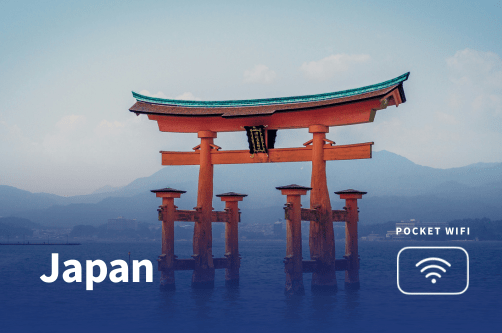
Reliable WiFi in Japan is not just for essentials like checking maps or booking tickets. It also makes downtime more meaningful, whether you are streaming entertainment on a train ride or looking up quirky fun facts about Japan that give new context to what you see around you.
Having your own connection means you are not tied to public hotspots or expensive roaming, which gives you more freedom and confidence as you explore. Pocket WiFi makes this possible by turning Japan’s mobile networks into your own private hotspot. Understanding how it works will help you see why it has become one of the most popular tools for travelers.
Choosing the right pocket WiFi in Japan can make a big difference in your travel experience.
With so many providers offering different plans, speeds, and pickup options, it’s important to compare prices and features before you book.
In this section, we prioritized the entry-level plans to give you a clear idea of the cheapest starting options. More extensive plans with higher data or added features can be found directly on each provider’s website.
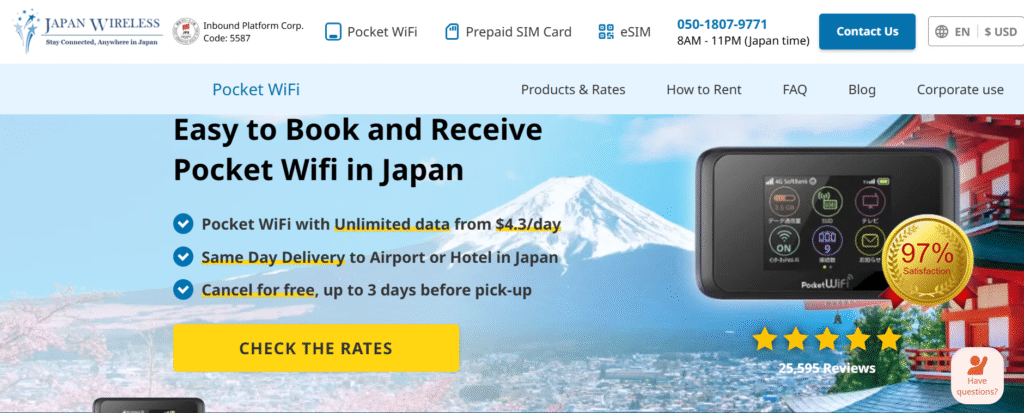
Japan Wireless’ Business WiFi plan is designed for travelers who need dependable internet throughout their stay.
The device offers a long battery life of about 18.5 hours and comes with a free power bank, ensuring you stay connected even on busy days.
Delivery options are flexible, with same day service available to airports or hotels in certain areas and standard delivery to residences or hotels usually taking one to two days.
Pick up is also possible at airport counters or post offices, giving you more convenience when starting your rental.
Returning the device is simple since a prepaid envelope is provided and it can be dropped in any mailbox in Japan.
Japan Wireless also offers Premium WiFi options, which provide upgraded performance and added features for travelers who want more than the standard plan.

NINJA WiFi’s Unlimited Plan is designed for single device use and provides reliable connectivity across Japan through the SoftBank network.
Delivery and pickup are flexible, with options at major airports, smart pickup locations, and direct hotel or accommodation delivery, while returns can be done at airports or designated counters.
Battery life details are not specified, but the devices are compact and easy to carry for daily use. If you exceed the 1 GB daily limit, speeds are reduced for the rest of the day, then reset the next day.
To enhance peace of mind, NINJA WiFi also offers a combined WiFi and medical insurance package that covers up to ¥10 million for ¥770 per day.
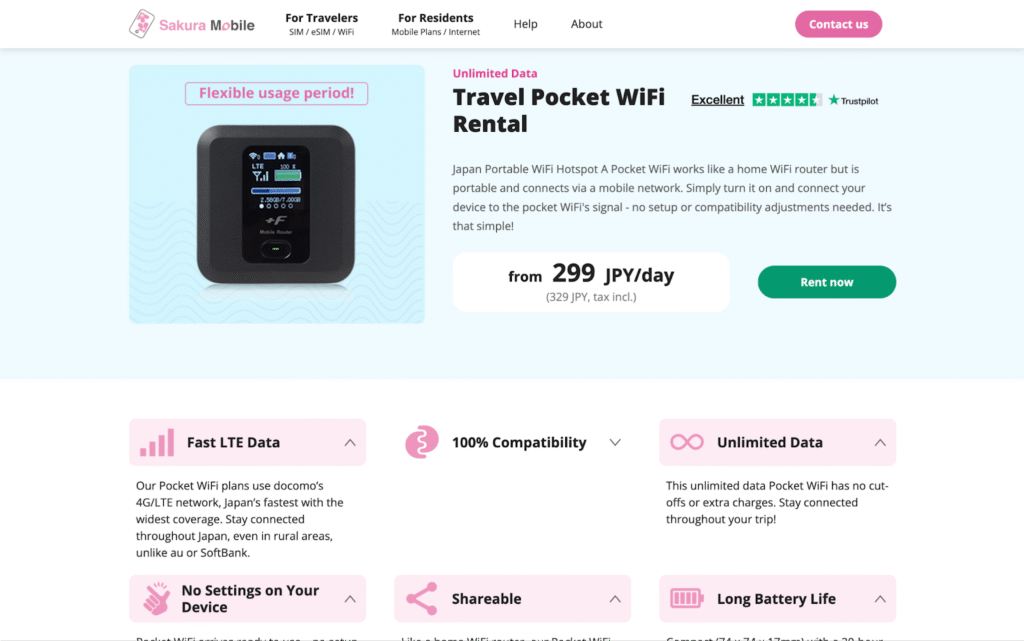
Sakura Mobile’s Travel Pocket WiFi runs on docomo’s 4G/LTE network, providing strong coverage across Japan. The device offers a battery life of up to 20 hours, making it reliable for long travel days without frequent charging.
Delivery and pickup are highly flexible, with options at major airports such as Narita, Haneda, Kansai, and Fukuoka, as well as hotels, residences including AirbnBs, and Sakura Mobile’s Shinjuku office.
Returns are equally convenient thanks to a prepaid envelope that lets travelers drop the device in any Japan Post mailbox, including those at departure lobbies in airports.
With long battery performance and easy delivery and return options, Sakura Mobile is a practical choice for visitors needing dependable WiFi in Japan.
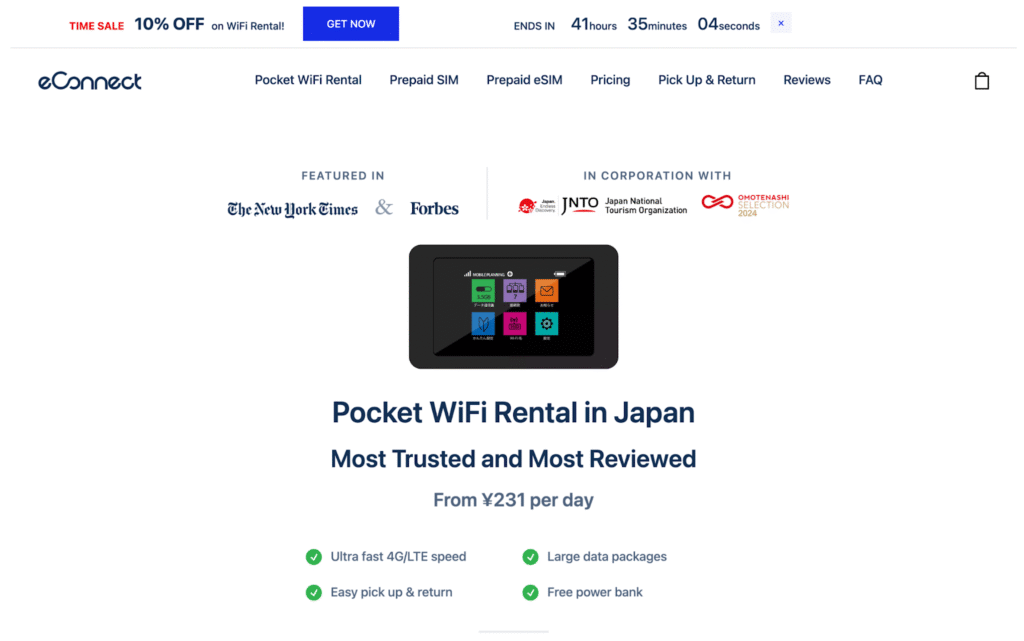
eConnect Japan’s Economy Plan offers reliable coverage through the SoftBank network, making it suitable for common travel needs like maps, browsing, and social media.
The device has a battery life of about 8 hours of active use and up to 120 hours on standby, and it comes with a free power bank for longer days. Delivery is convenient, with options to hotels, airports, and private residences, and returns are handled with a prepaid envelope that can be dropped into any Japan Post mailbox.
These features make the Economy Plan a practical and affordable option for travelers. eConnect also provides other Pocket WiFi plans, including Premium, Monster, and Unlimited options for those who need more data or higher performance.
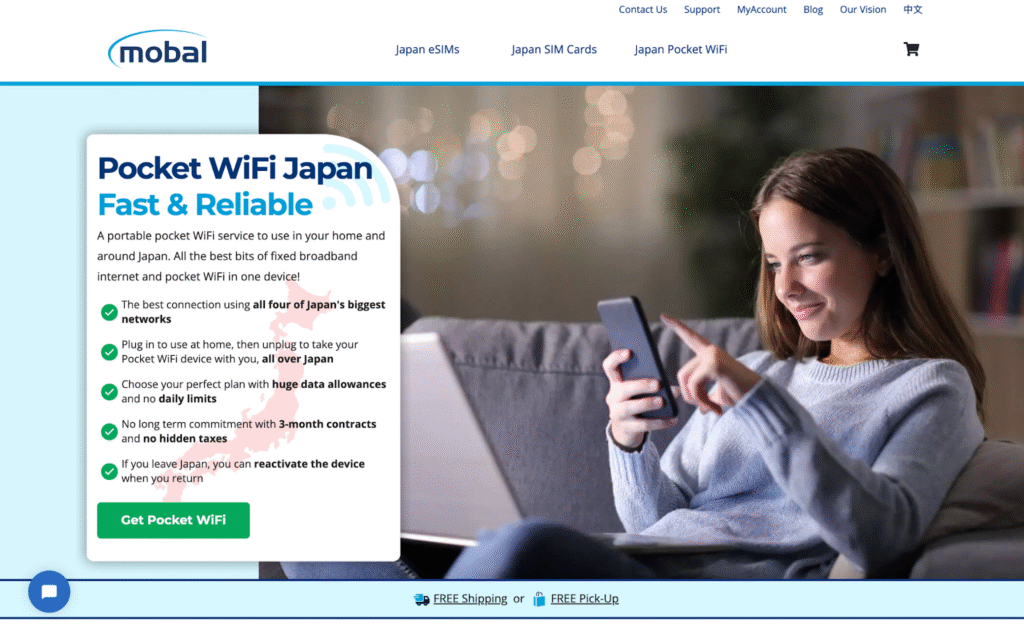
The Mobal Japan pocket WiFi is built with a 3,000 mAh battery that lasts up to 12 hours of continuous use when unplugged, making it suitable for a full day of travel.
For digital nomads or long-term visitors, keeping the device connected via USB allows it to stay powered on indefinitely, providing a seamless shift between mobile and workstation use. Delivery within Japan is free, with shipping typically taking 2 to 5 business days after placing an order.
For travelers arriving by air, same-day pickup is available at both Narita and Haneda airports. Since nationwide shipping is included at no extra cost, users don’t need to worry about hidden delivery fees. After your 3-month contract is complete, the Mobal pocket WiFi router is yours to keep, and you can even reactivate it if you return to Japan
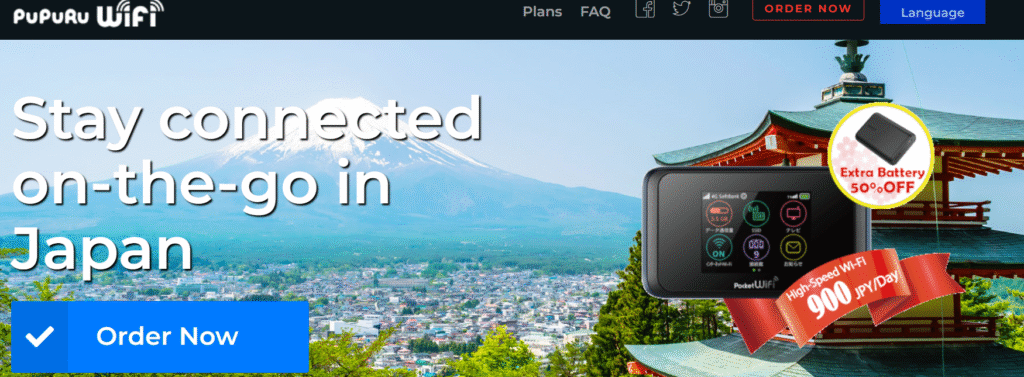
Pupuru’s pocket WiFi provides around 4 to 8 hours of battery life during normal use, though performance can vary depending on signal strength and the number of connected devices.
Since the unit can drain quickly, Pupuru advises travelers to carry an extra mobile battery to extend usage time throughout the day. Standard delivery, including return shipping, costs ¥1,800 and applies nationwide, with higher fees for remote areas such as Okinawa and Hokkaido.
Devices can be shipped directly to hotels, residences, or even Airbnb stays, but airport pickup is not available. Delivery times are flexible, with guaranteed arrival between 8:00 AM and 12:00 PM, plus alternative slots in the afternoon and evening to fit different schedules.
Choosing the right pocket WiFi in Japan depends on factors like cost, battery life, delivery convenience, and return options. The table below compares six popular providers to help you quickly see which service best matches your travel needs.
| Provider | Daily / Monthly Cost | Data Allowance | Network / Speed | Device Connections | Battery Life | Delivery & Pickup | Returns |
| Japan Wireless | ¥623.2/day (28-day rental) | Unlimited | 4G/LTE | Up to 5 | ~18.5 hrs, free power bank included | Same-day to airports/hotels; 1–2 days standard to residences | Prepaid envelope, drop in any mailbox |
| Ninja WiFi | ¥440/day | 1 GB/day (reduced after limit) | 4G | Multiple (not specified) | Not specified | Major airports, smart pickup spots, hotels, residences | At airports or designated counters |
| Sakura Mobile | ¥299/day | Unlimited | 4G/LTE | Up to 15 | Up to 20 hrs | Airports (Narita, Haneda, Kansai, Fukuoka), hotels, residences, Shinjuku office | Prepaid envelope, drop in any Japan Post mailbox |
| eConnect Japan | ¥231/day | 20 GB | 4G/LTE | Up to 14 | ~8 hrs active, 120 hrs standby, free power bank included | Delivery to hotels, airports, residences | Prepaid envelope, drop in any Japan Post mailbox |
| Mobal Japan | ¥4,980/month (+ ¥6,980 device fee) | 300 GB/month (reduced after limit) | 4G/LTE | Not specified | ~12 hrs; unlimited use when plugged via USB | Free nationwide shipping (2–5 days), same-day pickup at Narita & Haneda | Included in free delivery, no extra cost |
| Pupuru WiFi | ¥900/day | Unlimited | 4G/LTE | Up to 10 | 4–8 hrs (advised to carry extra battery) | Nationwide delivery ¥1,800; to hotels, residences, Airbnb (no airport pickup) | Return via prepaid envelope, flexible slots |
A pocket WiFi is a small portable device that uses local mobile networks to create a personal WiFi hotspot.
Pocket WiFi in Japan gives travelers a secure and reliable way to stay connected, whether they are navigating Tokyo’s busy streets, checking train schedules in Osaka, or exploring temples in Kyoto.
Key benefits of using a pocket WiFi in Japan:
With a pocket WiFi, you get flexibility, convenience, and reliable internet that keeps your trip running smoothly.
Using pocket WiFi in Japan can be a practical way to stay connected, but it comes with both advantages and drawbacks. Here are some of the most common pros and cons travelers should consider.
Pros:
Cons
If you don’t want to carry an extra device, eSIMs are a convenient alternative to pocket WiFi in Japan. They activate instantly on compatible phones, often cost less than daily WiFi rentals, and provide reliable coverage through major local networks.
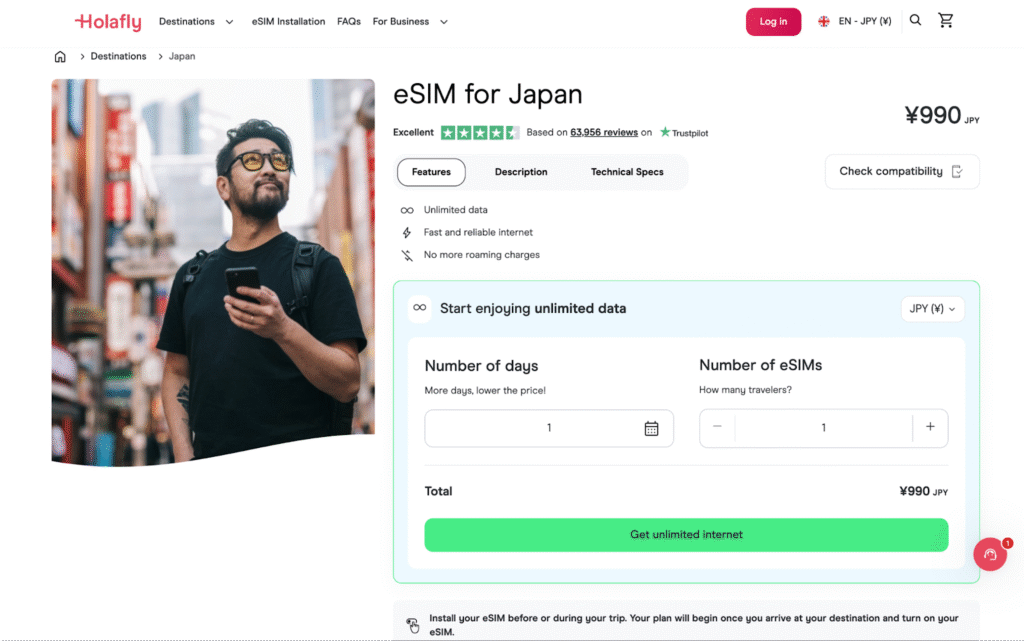
Holafly offers prepaid eSIM plans for travelers to Japan with unlimited data on 4G/LTE, with fallback to 3G or 5G where available. You receive a QR code after purchase to install the eSIM directly on your phone before arrival. Their plans vary by duration such as 5, 10, or 15 days rather than fixed data caps. Hotspot and tethering may be limited to about 500 MB per day based on user reports. The service costs ¥990 per day for unlimited data.
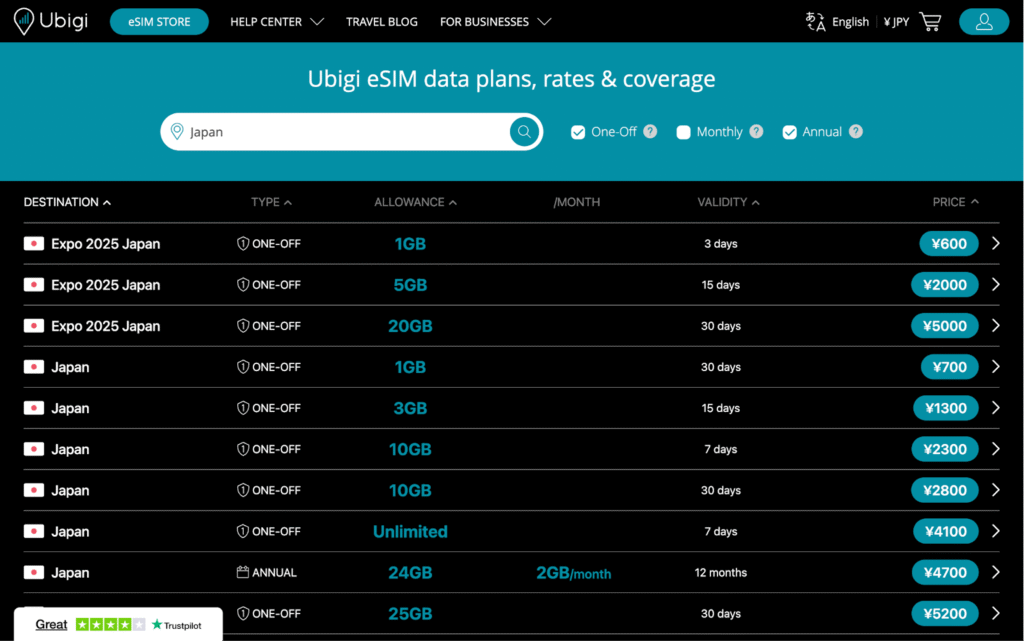
Ubigi provides flexible prepaid eSIM data plans for Japan. They offer a one-off unlimited data plan for ¥4,100 that lasts 7 days. The eSIM is data-only with no voice or SMS, and setup is done through a QR code or the Ubigi app. It uses Japanese networks like Docomo to provide robust coverage, especially in rural areas.

Nomad’s Japan eSIM plans are data-only and include both fixed data and unlimited-style daily capped plans. They offer a 7-day unlimited data plan for ¥3,403. Their eSIM supports 4G and 5G speeds in Japan with wide coverage through major local networks like KDDI and SoftBank. Nomad is often praised for its flexibility and easy-to-use app.
| Provider | Data Type / Style | Price / Plan Example | Best For | Trustpilot Rating | |
| Holafly | Unlimited by duration (5, 10, 15 days) | ¥990 per day, unlimited data | Heavy data users who want simplicity and unlimited browsing | 4.5 / 5 | |
| Ubigi | Unlimited (one-off plan) | ¥4,100 for 7 days unlimited | Travelers needing strong rural coverage with a one-off short plan | 4.1 / 5 | |
| Nomad | Unlimited-style daily capped plans | ¥3,403 for 7 days unlimited | Budget-conscious users who want flexible plans and app-based setup | 4.4 / 5 | |
Holafly stands out as the best option because it offers true unlimited data without worrying about daily caps or running out mid-trip. Its simple setup and fixed daily pricing make it the most convenient choice for travelers who want stress-free connectivity in Japan. Having reliable internet ensures you get the best experience during your visit, whether that means exploring top attractions or planning around the best time to visit Japan.
Yes, pocket WiFi is worth it if you want reliable internet for multiple devices and group travel. It helps avoid expensive roaming charges and unreliable public WiFi.
Yes, travelers can rent pocket WiFi devices from providers like Japan Wireless, NINJA WiFi, and Sakura Mobile. These devices connect to local networks and create a personal hotspot you can use anywhere in Japan.
Prices usually range from about ¥231 to ¥900 per day depending on the provider and plan. Monthly options like Mobal Japan start at ¥4,980 plus a one-time device fee.
An eSIM is often cheaper for solo travelers since plans start around ¥2,000–¥4,000 for a week. Pocket WiFi can be more cost-effective for groups because one device can support several users.
Sakura Mobile and Japan Wireless are top choices thanks to long battery life, flexible delivery, and reliable coverage. The “best” depends on whether you prefer unlimited data, low daily cost, or premium features.
Yes, pocket WiFi devices allow multiple connections at the same time, so two people can easily share one unit. Some providers support up to 10 or even 15 devices simultaneously.
Many providers advertise unlimited data, but some like NINJA WiFi enforce a 1 GB daily limit before speed reduction. Others, such as eConnect, set fixed allowances like 20 GB per plan.

